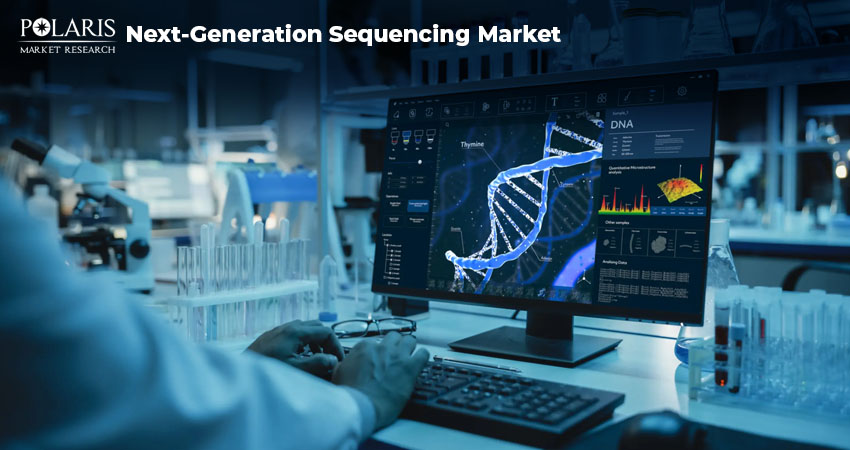Top 10 Next-Generation Sequencing Companies in Global Market 2024
The advent of next-generation sequencing has brought about a paradigm shift in the world of genomics. The transformative technology has led to genomic advancements across various domains. It offers unmatched capabilities to analyze RNA and DNA molecules in a high-throughput and cost-effective way. But what is it about next-generation sequencing that gives it the capability to analyze millions of DNA fragments simultaneously?
In this blog post, we take you to the realm of next-generation sequencing, explaining to you how the technology provides detailed information about genomes and genetic variations. Also, we shed light on the top companies offering next-generation sequencing solutions and driving advances in genomic research. Continue reading to learn more!

What Is Next Generation Sequencing?
Next generation sequencing (NGS), also known as high-throughput sequencing, is a new method to analyze genetic material. It enables the rapid sequencing of large amounts of DNA or RNA fragments. Unlike conventional sequencing methods, the technology can sequence millions of DNA or RNA fragments at once. Also, DNA sequencing, as offered by the DNA sequencing market key players, is done much more cheaply as compared to Sanger sequencing and other sequencing methods. Next-generation sequencing supports a broad range of applications, including molecular analysis, chromosome counting, and detection of epigenetic genes.
According to our latest assessment, the next generation sequencing market stood at USD 10.4 billion in 2024. It is expected to witness robust growth and is poised to register a CAGR of 14.2% between 2025 and 2034. Improvements in sequencing technologies and rising utilization by pharmaceutical and biopharmaceutical companies are the key factors driving market growth.
How Does Next Generation Sequencing Work?
Next generation sequencing involves four basic steps. These include:
Step 1: Extraction
The next generation sequencing process begins with the extraction stage. Here, the isolation of nucleic acids (DNA or RNA) from the sample takes place. It is carried out by lysing cells and purifying the genetic material from other genetic materials. This results in pure DNA or RNA ready for sequencing.
Step 2: Library Preparation
Next generation sequencing requires the creation of a sequencing “library” from the sample. During library preparation, the DNA sample is fragmented into short, double-stranded fragments. Based on the specific application, DNA fragmentation can be done in various ways, including enzyme digestion, physical shearing, and PCR-based amplification of specific genetic materials. After fragmentation, the DNA fragments are ligated to technology-specific adaptor sequences to form a fragment library.
Step 3: Sequencing
During the sequencing stage, a sequencing instrument is used to sequence all of the DNA in the library simultaneously. Although each NGS technology is unique, all of them make use of a version of the sequencing by synthesis method. The sequencing method detects individual bases as their incorporation into growing DNA strands takes place. After this, the reactants are removed to restart the cycle.
Step 4: Data Analysis
Every next generation sequencing experiment results in the generation of large quantities of complex data. While every technology platform uses its own algorithms and tools from the healthcare analytics market, they employ a similar analysis pipeline and make use of common metrics for evaluating the quality of NGS datasets. Data analysis offers results that are relevant to the research question of the NGS experiment.
What Are Major NGS Market Metrics?
According to our latest assessment, the next generation sequencing market stood at USD 10.4 billion in 2024. It is expected to witness robust growth and is poised to register a CAGR of 14.2% between 2025 and 2034. Improvements in sequencing technologies and rising utilization by pharmaceutical and biopharmaceutical companies are the key factors driving market growth.
What Are Commonly Used NGS Technologies?
There are several types of NGS technologies that cater to the diverse needs and preferences of users. The most common ones include:
Illumina (Solexa) Sequencing: Illumina sequencing is based on the sequencing by synthesis method and reversible dye-terminators concept. It works by determining the series of base pairs of DNA and adding them to a nucleic acid chain.
Ion Torrent Sequencing: Ion Torrent sequencing is based on the detection of hydrogen ions released during DNA polymerization. As a sequencing-by-synthesis method, Ion Torrent sequencing involves the development of a complementary strand based on a sequence of template strands.
Roche 454 Sequencing: This next generation sequencing technique is based on large-scale pyrosequencing. It employs the spray method to break DNA samples into small fragments of 300-800bp. It makes use of a light signal to detect pyrophosphate.
Which Are the Top Next Generation Sequencing Companies?
The next generation sequencing market has the presence of both established players and new entrants. These players are undertaking a variety of strategic initiatives to expand their global footprint. Also, they are investing in research and development to improve their product offerings. Below, we’ve listed the top companies offering nex -generation sequencing solutions:
Genomatic AG
Founded: 1997
Headquarters: Munich, Bavaria
Genomatic AG is one of the world’s leading suppliers of technologies for analyzing and interpreting genomic data. It offers hardware, software, and service solutions that help users analyze microarray and next generation sequencing experiments. Genomatic’s solutions support all the major NGS platforms, enabling users to access a large pool of data from different sources.
Illumina Inc.
Founded: 1998
Headquarters: San Diego, CA
Illumina Inc. is an American biotech company that manufactures integrated systems for analyzing genetic variation and biological function. The company has a wide consumer base, including pharmaceutical companies, genomic research centers, clinical research organizations, and biotechnology companies. Illumina undertakes various strategic initiatives to expand its product offering and global reach. For instance, in December 2023, Illumina announced its partnership with aploX to offer locally manufactured sequencing instruments in China.
Roche Ltd
Founded: 1896
Headquarters: Basel, Switzerland
Roche is a Swiss multinational holding healthcare company. It operates globally under two divisions: pharmaceuticals and diagnostics. Since its founding, the company has been developing innovative medicines, treatments, and diagnostics that continue to transform healthcare. Roche has differentiated medicines for infectious diseases, ophthalmology, immunology, and oncology. The WHO’s list of essential medicines currently includes 30 medicines developed by Roche.
Oxford Nanopore Technologies
Founded: 2005
Headquarters: Oxford, United Kingdom
Oxford Nanopore Technologies was founded as a spin-out from the University of Oxford. The company has developed a new generation of DNA/RNA sequencing technology that can analyze DNA or RNA sequences of any length and provide short to ultra-long read lengths. Also, it keeps adding new products to its portfolio to cater to diverse requirements. For example, in December 2023, Oxford Nanopore launched its benchtop instrument TurBOT beta access in partnership with Tecan.
Along with these, other major companies operating in the next generation sequencing market are:
Bio-Rad Laboratories, Inc.: The company provides products and solutions for NGS. Its main focus is on the library preparation stage and single-cell analysis.
DNASTAR: DNASTAR is a bioinformatics company that develops software for NGS analysis. It also offers related tools for primer design and sequence alignment.
Eurofins GATC Biotech GmbH: The company provides NGS services for a wide range of applications. These include genome sequencing, exome sequencing, and transcriptome analysis.
BGI: BGI makes use of NGS technologies for a wide range of research and clinical applications.
Thermo Fisher Scientific Inc.: Thermo Fisher Scientific provides NGS solutions primarily through its Ion Torrent semiconductor technology. Its solutions are designed to be fast, simple, and scalable.
How AI is Changing the Next Generation Sequencing Market?
AI helps improve the quality and efficiency of data analysis in NGS. It allows for the quick interpretation of complex genomic data. Machine learning algorithms analyze genomic information to detect patterns and mutations. This improves the diagnosis of diseases and helps in creating personalized treatment plans. Errors are reduced with the use of AI and the process is also made faster. AI also supports enhanced research and clinical applications.
Enabling Whole Genome Sequencing
The next generation sequencing market offers an innovative genome sequencing method that’s faster, more accurate, and less expensive than other methods. NGS can assess multiple genes in a single assay, thereby reducing the need for multiple tests. Also, it can sequence an entire genome in a single experiment. As technology advances and market participants introduce more advanced next generation sequencing methods, the applications of next generation sequencing in the fields of oncology, infectious disease, and prenatal diagnostics are anticipated to rise.


